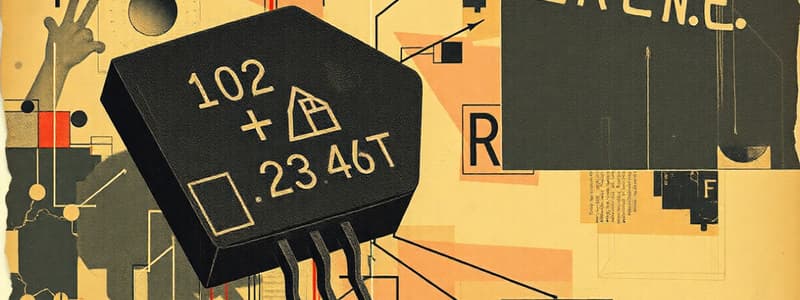Podcast
Questions and Answers
Which characteristic is true for the Common Source (CS) configuration of a JFET?
Which characteristic is true for the Common Source (CS) configuration of a JFET?
- Low voltage gain
- Used primarily in digital circuits
- Phase inverted output signal (correct)
- Low input impedance
What distinguishes the Common Gate (CG) configuration from the other JFET configurations?
What distinguishes the Common Gate (CG) configuration from the other JFET configurations?
- Its output signal is in-phase with the input. (correct)
- It is used mostly in audio applications.
- It uses the gate as the input terminal.
- It has the highest input impedance among configurations.
Which statement about the MOSFET is correct?
Which statement about the MOSFET is correct?
- MOSFETs utilize an insulated gate to control output. (correct)
- MOSFET stands for Metal Oxide Structural Field Effect Transistor.
- MOSFETs are variations of bipolar transistors.
- MOSFETs operate primarily in analog applications.
What is a key feature of the Common Drain (CD) configuration in a JFET?
What is a key feature of the Common Drain (CD) configuration in a JFET?
Which of the following is not a typical application of the Common Source (CS) configuration?
Which of the following is not a typical application of the Common Source (CS) configuration?
What does MOSFET stand for?
What does MOSFET stand for?
Which mode can a JFET operate in?
Which mode can a JFET operate in?
Which of the following statements is true regarding the terminals of MOSFET?
Which of the following statements is true regarding the terminals of MOSFET?
What is a characteristic of the input impedance of JFET?
What is a characteristic of the input impedance of JFET?
Which type of MOSFET is not matched with its category?
Which type of MOSFET is not matched with its category?
Flashcards are hidden until you start studying
Study Notes
Bipolar Junction Transistor (BJT) Devices
- A BJT is a three terminal device with terminals labeled Source, Drain, and Gate.
JFET Modes of Operation
- JFET's are a type of field-effect transistor that utilize a junction between a semiconductor and a metal to control current flow.
- Common Source (CS) configuration:
- Most common mode of operation.
- High input impedance.
- High voltage gain.
- Used in audio frequency amplifiers.
- Output signal is 180 degrees out-of-phase with the input.
- Common Gate (CG) configuration:
- Input terminal is the Source.
- Output terminal is the Drain.
- Low input impedance.
- High output impedance.
- Used in high frequency and impedance matching circuits.
- Output signal is 0 degrees in-phase with the input.
- Common Drain (CD) configuration:
- Input terminal is Gate.
- Output terminal is Source.
- High input impedance.
- Low output impedance.
- Near-unity voltage gain.
- Used in buffer amplifiers, also called source followers.
- Output signal is 0 degrees in-phase with the input.
Field Effect Transistor (FET) Biasing
- FET biasing is the process of setting the operating point for a FET amplifier.
MOSFET
- MOSFET stands for Metal Oxide Semiconductor Field Effect Transistor.
- It is a voltage-controlled device.
- Also called an Insulated Gate Field Effect Transistor (IGFET).
- Used for switching or amplifying electronic signals in electronic devices.
- The most commonly used transistor.
- Used in both analog and digital circuits.
MOSFET vs. JFET
- MOSFETs are voltage-controlled devices with higher input resistance than JFETs.
- JFETs have a continuous channel, while MOSFETs have a channel that only exists in the depletion mode.
- JFETs are less susceptible to damage than MOSFETs because of the presence of metal oxide.
- MOSFETs have a higher signal handling capacity than JFETs.
- MOSFETs are more expensive to manufacture due to the use of metal oxide.
- The gate terminal of a MOSFET is insulated from the channel, while the gate terminal of a JFET is directly connected to the channel.
- JFETs have a more flat characteristics curve than MOSFETs.
- The conductivity of a JFET is controlled by the reverse bias of the gate, while the conductivity of a MOSFET is controlled by the charge carriers induced in the channel.
Studying That Suits You
Use AI to generate personalized quizzes and flashcards to suit your learning preferences.




